You'll discover seven reliable methods to create pure botanical perfumes at home. Traditional steam distillation extracts essential oils using copper equipment, while low-temperature vacuum distillation preserves delicate flowers. Cold-press maceration with carrier oils offers a simple approach, and modern CO2 extraction provides clean results. The classic enfleurage method, alcohol-based tinctures, and hydrosol production round out your options. Each technique reveals unique fragrant possibilities waiting to be explored.
Traditional Steam Distillation: Creating Pure Essential Oils
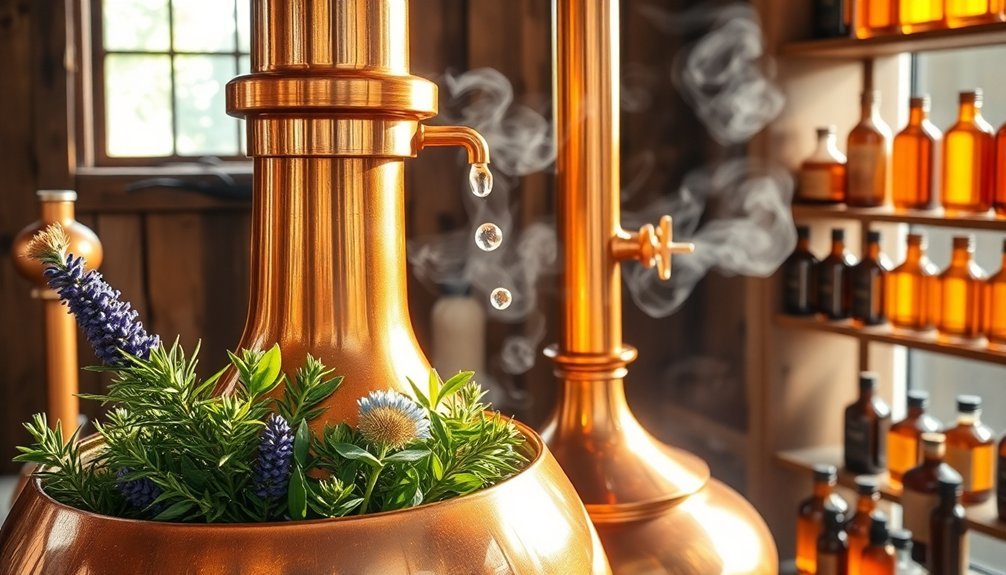
While steam distillation may seem complex at first, this time-tested method remains one of the most effective ways to extract pure essential oils from botanical materials.
You'll need to start by selecting premium plant materials at their peak aromatic intensity and preparing them properly by finely chopping or grinding them to maximize extraction. Skilled distillers carefully oversee each step of the process with deep expertise.
Set up your still with clean copper equipment, ensuring you've got a reliable condenser and proper safety gear in place.
You'll pass steam through your prepared plant material, which causes the aromatic compounds to evaporate. As the steam and oil vapors rise, they'll condense in your cooling system. The resulting liquid will naturally separate, with your essential oil floating on top of the hydrosol.
Maintain precise temperature control throughout the process to preserve the therapeutic properties of your botanicals.
Low-Temperature Vacuum Distillation for Delicate Flowers
When working with delicate flowers like jasmine and rose, you'll need to use low-temperature vacuum distillation to preserve their fragile aromatic compounds. This method uses a vacuum pump to lower the boiling point of liquids, allowing you to extract essential oils at reduced temperatures without damaging the botanicals.
You'll require specialized equipment, including stainless steel components and foam breakers, to maintain the vacuum environment and guarantee efficient distillation. Take time to prepare a distillation journal to document your process and results.
The process is solvent-free, which means you won't risk contaminating your final product. As you monitor the temperature and pressure levels, you'll achieve higher yields of pure, refined essential oils that capture the true scent of your flowers.
This technique works particularly well in laboratory settings and for producing high-quality botanical perfumes from heat-sensitive materials.
Cold-Press Maceration With Natural Carrier Oils
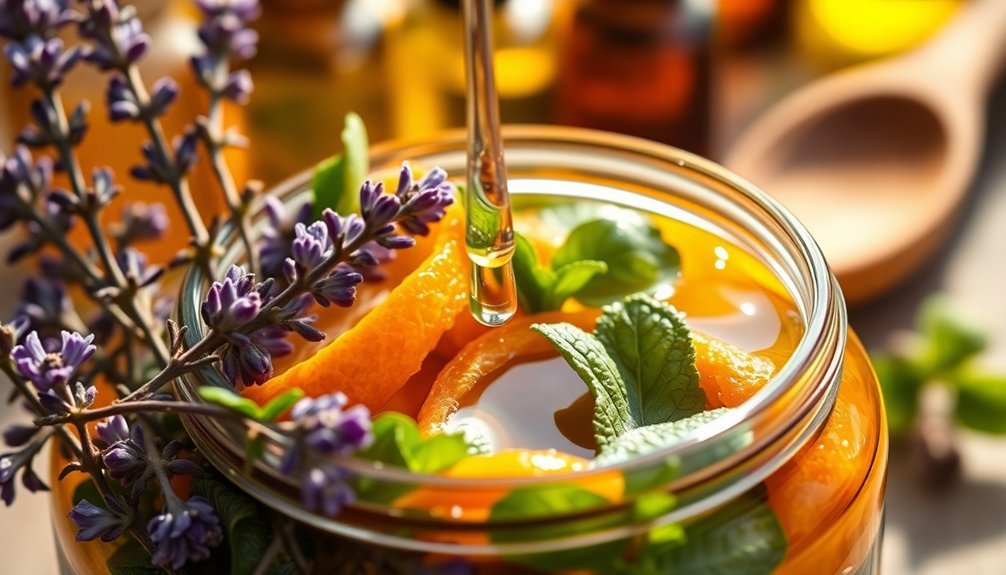
When creating botanical perfumes through cold-press maceration, you'll first need to select a carrier oil that matches your needs, with jojoba and sweet almond being excellent choices for beginners.
You can maximize your extraction by choosing fresh, fragrant flowers like jasmine, rose, or lavender that have been slightly dried to prevent moisture-related spoilage. While this method takes longer to complete, it's an ideal hands-on approach for artisan perfumers looking to experiment with different botanicals.
To achieve the best results, you'll want to let your flower-oil mixture rest in a dark place for several weeks, gently agitating it periodically to enhance the extraction process.
Choosing Your Carrier Oil
Selecting the right carrier oil serves as the foundation for creating successful botanical perfumes through cold-press maceration.
You'll want to take into account oils like jojoba, which mimics your skin's natural sebum, or sweet almond oil for its light, easily absorbable properties. If you're seeking a non-greasy base, fractionated coconut oil is your best bet, as it stays liquid and blends beautifully with essential oils.
For ideal results, look for cold-pressed varieties that retain their nutritional integrity and natural composition.
You'll need to blend about 15-30 drops of essential oils per ounce of carrier oil. Remember to check for potential allergens – particularly with nut-based oils like sweet almond.
Store your blends in dark glass bottles to prevent oxidation, and allow them to mature in a cool, dark place.
Best Flowers For Maceration
The art of botanical perfumery hinges on choosing the right flowers for maceration. You'll want to focus on fragrant blooms like gardenia, lavender, rose, jasmine, and marigold, which release their aromatic compounds effectively when infused in carrier oils.
Always select fresh, organic flowers at their peak bloom and handle them gently to preserve their delicate properties. You'll need to partially dry them first to prevent moisture-related spoilage, but don't over-dry, as this can diminish their scent.
Consider the season when selecting your flowers to guarantee superior aroma quality.
For best results, use cold maceration by soaking your flowers in oil for several weeks. This method's particularly effective for capturing the subtle nuances of fragile blooms like jasmine and gardenia, while preserving their therapeutic properties.
Maximizing Extraction Time
To achieve ideal fragrance extraction during cold-press maceration, you'll need to carefully monitor and adjust the timing based on your chosen botanicals and carrier oils.
Start by drying your fresh flowers for 3-6 hours to remove excess moisture while preserving their fragrant properties.
Place your semi-dried botanicals in a glass container and cover them completely with your selected carrier oil – grapeseed, apricot kernel, or sweet almond oil work best.
Seal the container tightly and store it in a cool, dark place. You'll want to gently agitate the mixture periodically to enhance extraction.
Let your mixture macerate for several weeks to months, checking the scent intensity regularly.
Once you've achieved your desired fragrance, filter out the botanical materials and allow the final mixture to mature for a few additional weeks.
Modern CO2 Extraction at Home
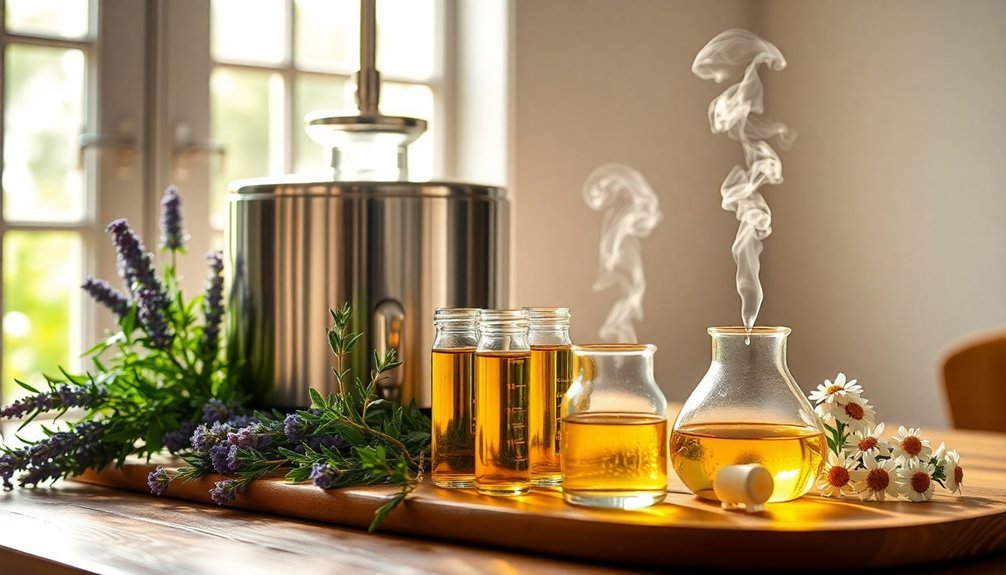
Modern CO2 extraction has revolutionized the way perfume enthusiasts create botanical extracts at home.
You'll need a specialized CO2 extraction system like the melloeX, which uses dry ice as your CO2 source. Set up your extractor with chilled water flowing through the condenser to convert CO2 gas to liquid.
Place your botanicals in the airtight chamber with filters, then let the pressurized CO2 (up to 800 psi) work its magic.
The process combines low heat and high pressure to create pure extracts without damaging the delicate aromatic compounds. You'll get superior results compared to traditional distillation – your extracts will be cleaner, purer, and more authentic to the original plant scent.
Plus, you won't need to worry about harmful solvent residues or environmental impact since CO2 is both safe and recyclable.
Classic Enfleurage Using Natural Fats
Your success with enfleurage starts by spreading a thin, even layer of refined coconut oil or shea butter on a glass tray, creating the perfect base to capture floral essences.
You'll want to select freshly picked flowers like jasmine, gardenia, or lilac that continue releasing oils after harvesting, placing them gently on the fat surface and replacing them daily until the desired fragrance intensity is achieved.
While the process requires patience, you can enhance your results by harvesting flowers on dry days and allowing them to slightly wilt before use, which concentrates their aromatic compounds.
Traditional Fat Layering Process
Classic enfleurage stands as one of perfumery's most time-honored techniques for capturing delicate floral scents.
To begin the traditional fat layering process, you'll need to spread your chosen fat mixture onto glass plates set within a wooden chassis. The fat base can be either animal-derived (like tallow) or plant-based (like coconut oil and shea butter).
You'll need to layer fresh flowers on the fat surface daily, replacing them every few days. This process continues for about 60 days until the fat becomes fully saturated with fragrance.
Here's what makes this method unique:
- The fat captures fragrant molecules from flowers that continue releasing scent after being picked
- You can process up to 30 charges of fresh flowers in a single batch
- The final pomade requires alcohol washing to extract the pure fragrant oils
Optimal Flower Selection Tips
Three key factors determine the success of enfleurage: flower fragility, scent release patterns, and volatile compound profiles. You'll want to select flowers that are too delicate for steam distillation, like jasmine, violet, and lilac. These flowers continue releasing their fragrant oils hours after harvesting.
| Flower Type | Best Features | Handling Tips |
|---|---|---|
| Jasmine | Intense aroma, heat-sensitive | Replace daily, minimal touching |
| Rose | Long-lasting scent, versatile | Use fresh blooms, avoid bruising |
| Violet | Delicate profile, low oil content | Handle gently, frequent recharge |
| Tuberose | Continuous oil release, complex notes | Pick at peak bloom, keep cool |
When selecting your flowers, verify they're freshly picked and handle them minimally to preserve their fragrance integrity. You'll need substantial quantities for successful extraction, so consider seasonal availability in your planning.
Alcohol-Based Tincture Method
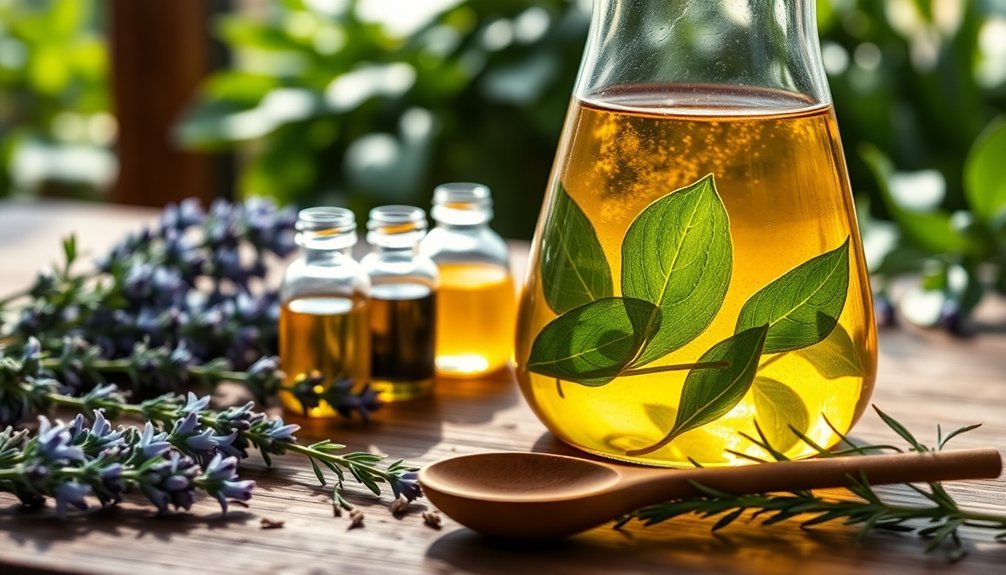
Creating botanical perfumes through alcohol-based tincturing begins with selecting the right base alcohol and preparing your botanical materials carefully.
You'll want to use 190-proof organic alcohol from clean sources, avoiding standard perfumer's alcohol that contains additives like bitrex.
For ideal extraction, consider these essential steps:
- Place fresh botanical materials in a jar, considering their water content and required extraction time
- Allow 24 hours for the initial extraction of essential oils and resins
- Filter and "fold" by adding more botanical material to maintain concentration
You'll find that different plants need specific solvency conditions, but the process rewards you with complex fragrances that blend beautifully through mid and base notes.
The tinctures you create will help fix scents to the skin, extending longevity while adding subtle depth to your perfumes.
Hydrosol Production From Fresh Botanicals
Although hydrosol production shares similarities with essential oil distillation, this gentle process yields delicate floral waters that capture a plant's water-soluble compounds.
You'll need to harvest your botanicals when they're in full bloom, typically during late spring or early summer, to guarantee maximum potency.
To begin distillation, load your fresh plant material into a copper still or adapted kitchen equipment. As steam passes through the botanicals, it releases both essential oils and water-soluble compounds.
You can optimize the process by running the still at a lower temperature for a longer duration. Once the steam condenses, you'll notice the essential oils floating on top of your hydrosol.
The resulting floral water contains unique antioxidants and beneficial compounds that make it perfect for skincare, aromatherapy, and natural perfumery.
Frequently Asked Questions
How Long Can Distilled Botanical Perfumes Maintain Their Original Scent Profile?
Your botanical perfume's scent profile can last 4-8 hours, depending on your skin type, climate, and the fixatives used. You'll get longer wear with proper application techniques and higher fragrance concentrations.
Which Flowers Are Toxic and Should Never Be Used in Perfume Distillation?
You shouldn't distill lily of the valley, as it contains lethal glycosides. While jasmine and tuberose aren't toxic, they're too delicate for distillation. It's safer to use synthetic alternatives for these flowers.
Can Botanical Perfumes Be Safely Mixed With Synthetic Fragrances?
You shouldn't mix botanical and synthetic fragrances. They're chemically incompatible and can cause skin irritation, alter natural scent profiles, and introduce harmful chemicals. It's best to keep your botanical perfumes pure and natural.
What Causes Cloudiness in Distilled Perfumes and How to Prevent It?
Your perfume's cloudiness stems from water interactions, temperature changes, poor formulation, and impure alcohol. You'll prevent it by using high-purity alcohol (95-97%), proper solubilizers, and maintaining stable temperatures during production.
Are There Legal Restrictions for Selling Home-Distilled Botanical Perfumes?
You'll need to follow FDA cosmetics guidelines and local regulations when selling home-distilled perfumes. While pre-market approval isn't required in the US, you must guarantee product safety and proper labeling compliance.
In Summary
You've now discovered seven reliable methods to create your own botanical perfumes at home. Whether you're working with delicate flowers or hardy herbs, there's a perfect distillation technique waiting for you. Start with simple methods like tinctures or hydrosols before advancing to more complex processes. Remember to always source fresh, high-quality botanicals and follow safety guidelines for the best aromatic results.


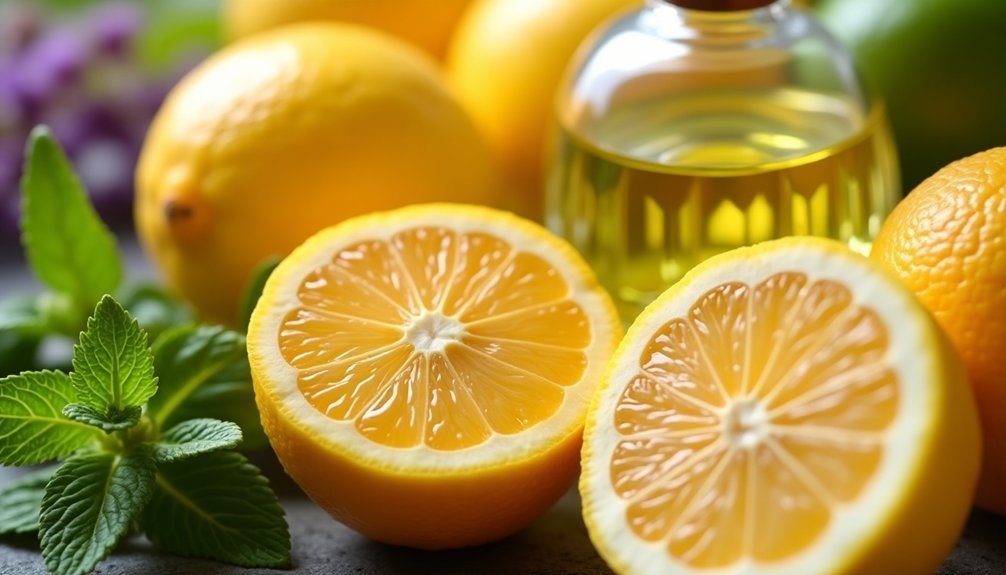
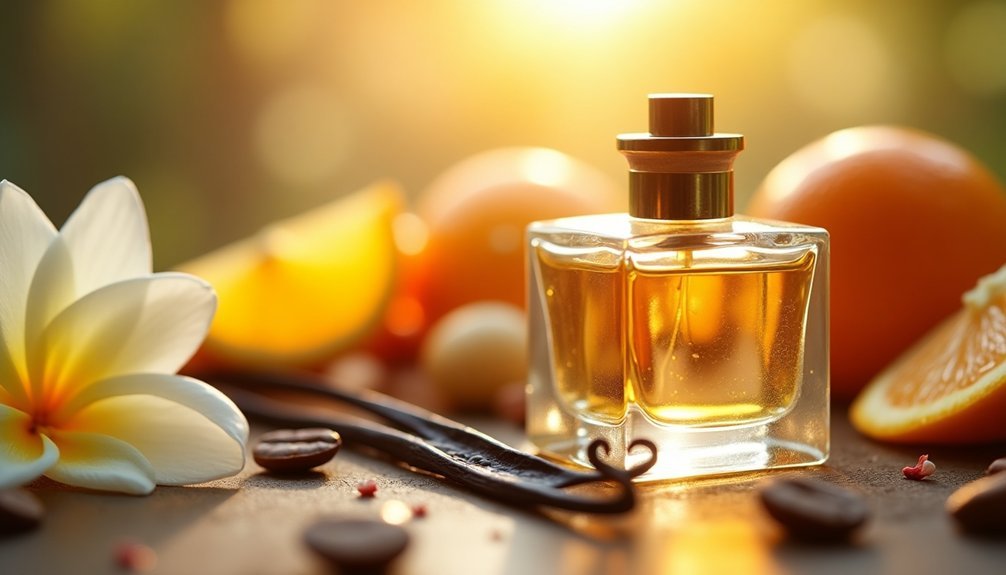

Leave a Reply